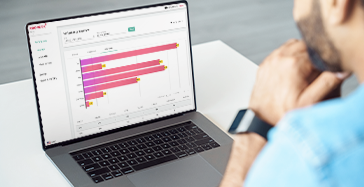Thought Leadership
Are Hotels Finally Ready to Embrace Attribute-Based Selling?

Hotels have gone through many changes over the years. However, one thing that has barely changed is the industry’s attitude towards room distribution. There has been lot’s of talks about attribute based selling (ABS), but yet it has not made it to the foreground.
The way in which hotel rooms are sold today, and have been for the past 20 years, has remained relatively the same. With the current model the guest journey is essentially made of a few specific moments. The consumer begins by choosing a hotel and stay date and receives a list of rates. These rates correspond to combinations of room types and rate plans and each combination has a price. Similarly, both the room type and rate have their own attributes attached such as max guest capacity, whether it has a view or a balcony, cancellation policies and/or the inclusion of certain features like meals or prepaid Wi-Fi. However, customers are not searching for those specific attributes, rather they filter the results to find the best specific room type and rate for their needs.
The problem with this model is that it leaves little control to the guests. Booking a hotel room is nearly a completely passive, top-down process. For example, within a single room type category some rooms offer impressive views while others are located near attractive hotel amenities such as pools or a fitness center, and others still are technically larger based on their location within the property. These are all attributes that guests value, but they are unable to choose during the room type driven booking process.
However, a concept known as attribute-selling model, or ABS for short, has generated buzz in hospitality circles in recent years. At its core, it is a different way of bundling/unbundling hotels services into multiple smaller units, each one with their own inventories and costs, allowing guests to search specific characteristics and book a room that matches their preferences.
The concept of selling by room categories was really cemented in the industry with the advent of self-service, OTA room bookings. In the old days, you could call a hotel and ask for specific room attributes. The person on the other line would use their knowledge of the property to offer you a room to match your preferences and they would then give you a rate. If you accepted, then, you were done with the booking. When OTAs came along – or online booking in general – you had a user with no knowledge of the property needing a way to understand the differences between the rooms. Room types were the most rudimentary way to explain the hotel. In addition, when OTAs came into power after September 11, 2001, travel was down and there was a rate war to attract guests. Travelers became focused on finding the lowest priced room possible. Room type categories offered a way to zero in on price, though at the expense of the real list of individual room attributes.
ABS, on the other hand, is a buyer-led process focusing on consumer choice. The concept of room types is eliminated and hoteliers break down their product bundles into individual services. If a guest is looking for a room, for example, a King Size bed with a sea view, and a balcony, the system will price each attribute separately and add an incremental price to the chosen base room rate. As the consumer creates their own product the hotel is not limited to a hard inventory count of a specific room type but can assign and re-assign rooms as long as those single attributes are available, creating a much larger inventory bucket. When booking, the customer creates their own product and pays for exactly what they want. Ultimately, with ABS, travelers are no longer limited by imprecise groupings of rooms, shifting from a few room types to a more targeted search that matches each room to a traveler’s preferences.
ABS seems revolutionary, yet is nothing new. Other industries already allow customers to personalize, take for example, Nike. With Nike, customers can choose how they want their sneakers, from the color of the flash on the side, to color cotton of the seam sewn in to create a one-off personalized pair. But it is the airline industry who has led the way in the implementation of the attribute-based selling.
Not so long ago, if you needed to travel by air, whether on holidays or for business you just booked the airline ticket that was needed to get to where you wanted to go, no questions asked. Similar to booking a room in a hotel, certain assumptions were made about what was included in the price – your seat, baggage, and perhaps some refreshments. Fast forward to the mid to late nineties, when airlines introduced the ABS model. Now when purchasing a ticket, what you are really buying is just a seat on a plane – anything else that has any value was, and still is, sold as an added item. Rather than a bundled solution each item such as baggage fees, travel insurance, speedy or priority boarding, onboard meals, advanced seat selection, additional frequent flier mileage points etc. are now sold as added extras in addition to the seat cost. Some airlines in particular (ultra-low-cost carriers) have mastered the art of unbundling air travel services.
While there might have been some furor in the beginning most consumers now are generally comfortable with, if not prefer, buying travel services a la carte rather than as a “bundled” or “all-in” traditional fare as it allows them to tailor and personalize their ticket to their needs. Not surprisingly, the selling of service in this way has become an extremely profitable source of revenue for airlines and has ballooned into a massive business. Last year, airlines raked in almost $110 billion in revenue globally from the sale of added services, with five of the largest U.S. airlines – American, Delta, United, Southwest and Alaska – forecasting a total of around $29.1 billion alone. Ancillary revenue now represents 12.2% of global airline revenue.
With much attention being drawn to this concept, hoteliers are starting to recognize benefits. ABS-driven shopping and room allocation lets hotels maximize the aspects that each individual values most. Attributes that individuals are neutral or negative about can be sold to others with different preferences and/or hotels would be able to up-sell guest rooms based on the demand for specific amenities. Either way, by better matching customer needs with property amenities – that they’re happy to pay a premium for – offers hotel owners a substantial revenue upside.
While the hospitality industry is in the early stages of adoption and practical application with hotel systems needing to be significantly modernized in order to start selling collections of specific guest-desired attributes instead of rooms and rates, “ABS matters to guests because it enables them to customize their purchase” (Dr. Ravi Mehrotra, IDeaS, and George Roukas, Hudson Crossing), there is little doubt that ABS distribution systems can contribute to increased profits for the hotel industry while providing a more personalized and better experience for guests.


